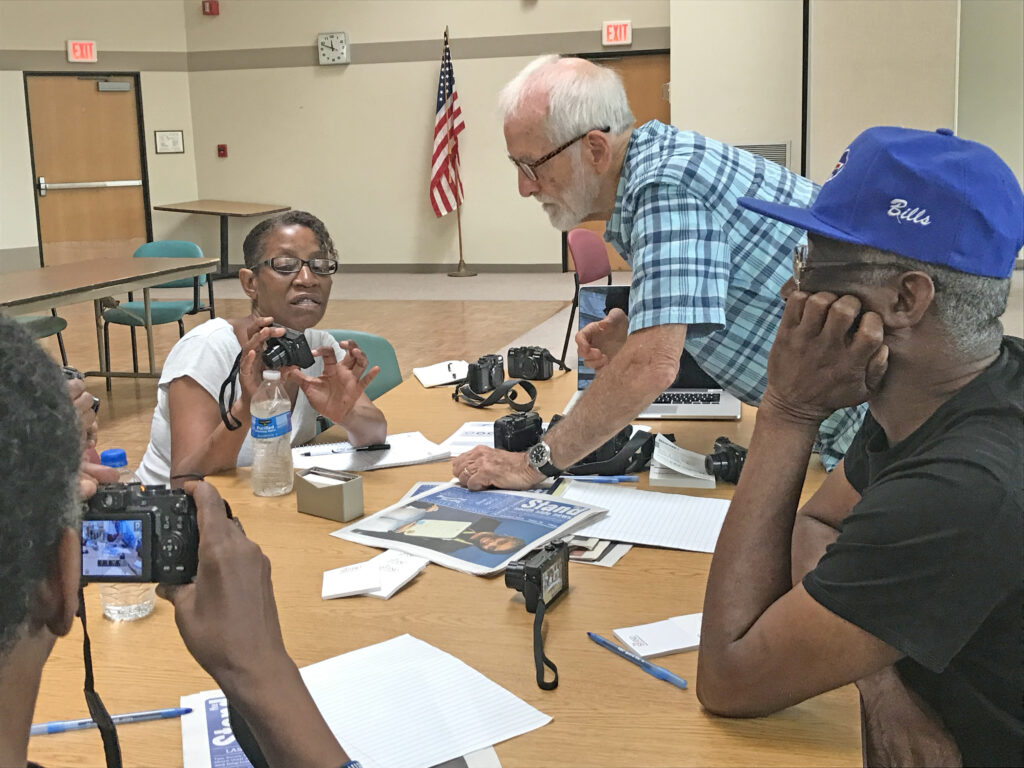Forced to skip 2020’s Photo Walk due to restrictions from the COVID-19 pandemic, our project’s most popular community training is back along with another citywide Photo Contest to capture often overlooked places in Syracuse, as well as the faces that call those places home. This month, a dozen photographers and community members have volunteered their time to lead five separate Photo Walks throughout the city. Another four will serve as photo judges to determine top picks.
While spots are nearly full for each walk, our summer photo contest is open for anyone to submit, as long as photos are taken this summer, within the boundaries of the city of Syracuse. Winning images will be displayed large and proud as part of the Urban Video Project, projected downtown on the side of The Everson Museum in mid-August. Select images will also be published in the September issue of The Stand, online and possibly used in official city materials — an even greater platform to celebrate all parts of the city. Entries are due Aug. 1.
Contest categories include:
• Street Life — A shot that best captures an activity or summer life from a Syracuse neighborhood
• Architecture — Capture our city’s angles, from Neoclassical Styles to the Arts & Crafts movement
• Portrait — A shot of the many faces of those who call Syracuse home
• Scenic — Capture Syracuse’s essence from a new vantage point
Top picks from each category will also be awarded prizes, including cash, local gift cards and more.
Prizes include:
1st Place: $200 Cash
2nd Place: One-year membership to Light Work & subscription to Contact Sheet
3rd Place: $75 gift certificate to Wildflowers Armory
4th Place: $50 in market money to Salt City Market
To help get you started, longtime Photo Walk volunteer Bob Gates has provided the following tips to help you take better photos.

Know How to Use Your Camera
• You can’t take a good picture if you don’t know how to use your camera. DUH!
• The most important thing is to get a shot that is in focus. With almost any camera this means learning how to gently half-press the shutter until a white, green or red square lights up to tell you what will be sharp, and then to gently press the shutter without moving the camera.
• It is also very important to use a fast enough shutter speed to overcome camera shake or movement of the subject.
• Make sure your camera meters the light properly to avoid over or under exposure. If you know how to do it, exposure compensation is a very useful camera setting.
• Set “picture quality” (this is called the resolution or number of pixels) to the highest quality.
• A more advanced photographic skill is to learn the relationship among the three things that determine proper exposure: shutter speed, aperture and ISO.
Some Elements of Composition and Design
• Fill the Frame: Everything in the frame should contribute to the effectiveness of the photograph. As you look through the viewfinder, imagine the photo hanging on your wall and check to see if there is anything that shouldn’t be in the image.

• Get Close: You don’t need to see the entire subject to know what it is.
• Have a Focal Point or Center of Interest: Know what it is that you want your viewer to pay the most attention to and how to emphasize that. Don’t let your photos become too “busy” with extraneous elements.
• It often works better not to have your subject dead center in the frame. There is something called the “rule of thirds” to help you think about this.
• Balance: If you have a strong subject on one side of the image, balance it by something on the other side.
• Find a diagonal “Leading Line” that carries your viewer’s eye into the frame or to your subject.

• Lines and patterns themselves can add interest to a photograph.
• Avoid having people, animals or vehicles, too close to the edge of the frame in front of them. They need to have room to be seen to move forward into the image, not be bumping into the edge of the frame.
• Rhythm: Look for regular or repeated elements in the composition that are similar but not identical to other elements.
• Create a “natural frame” around your subject to draw the eye in, like looking through trees or other elements of the composition.

• Perspective: Give interest or draw the eye by using an unconventional perspective — shoot on an angle, from above or below or use a wide-angle lens to give your photos impact.
Four Cardinal Rules
• Learn how to shoot with natural light.
• Learn how to use shallow depth of field to blur the background or isolate your subject.
• Try to capture strong human emotions.
• Simplify: When in doubt, leave it out.
 The Stand
The Stand


